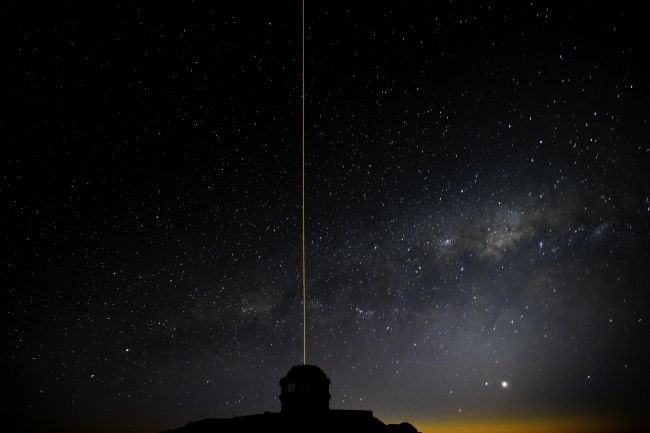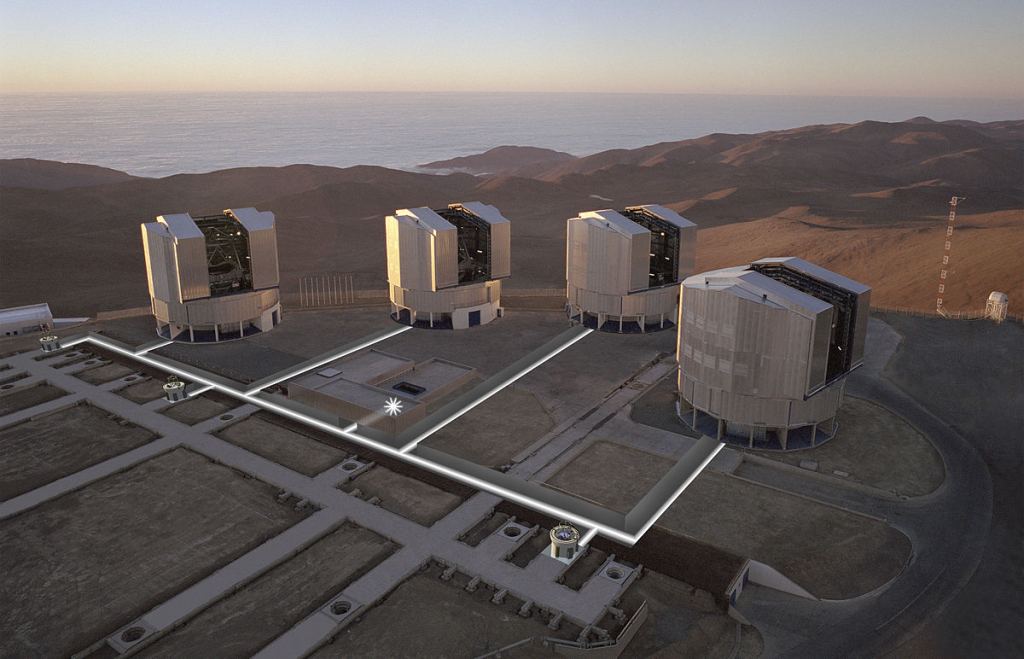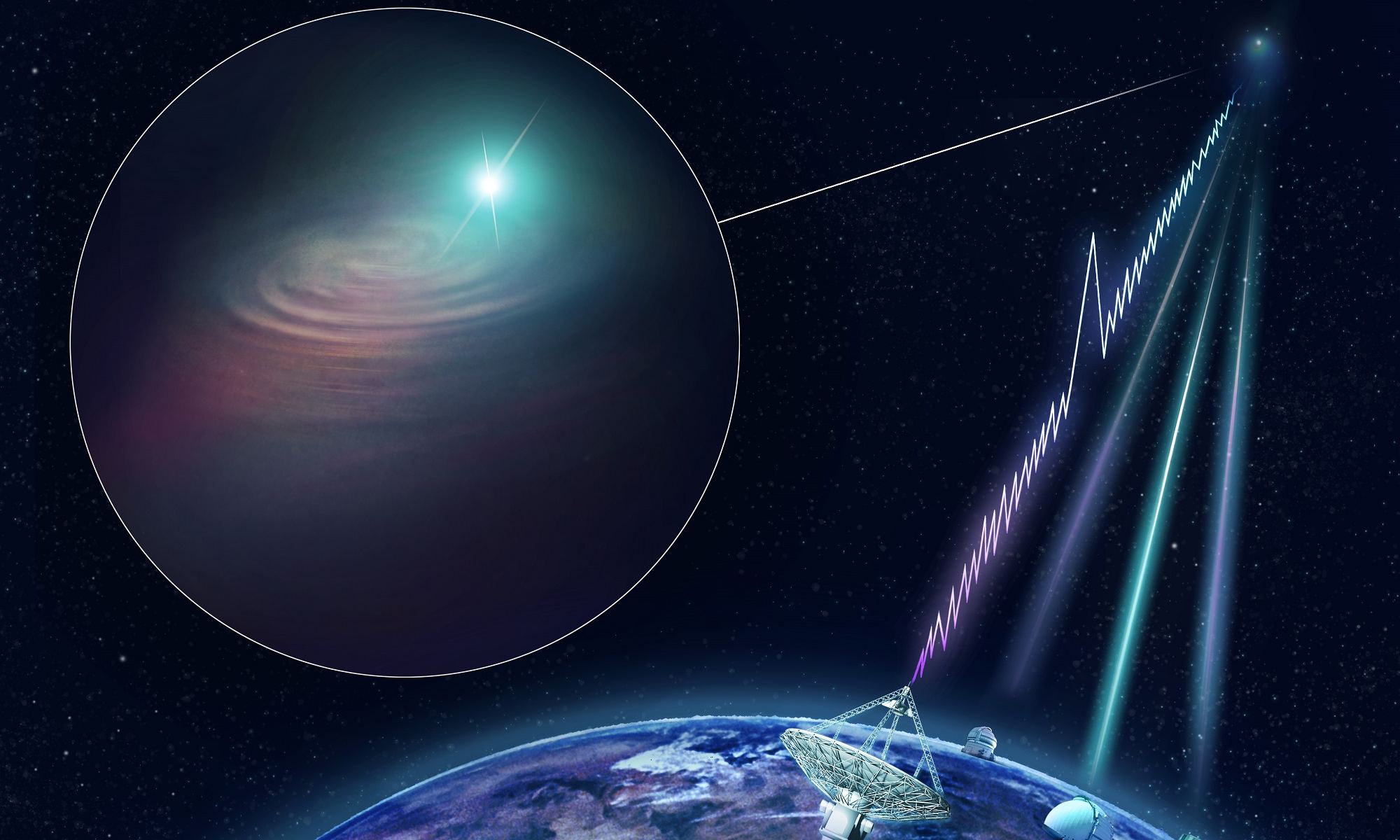Fast-Radio Bursts (FRBs) are one of the most puzzling phenomena facing astronomers today. Essentially, FRBs are brief radio emissions from distant astronomical sources whose cause remains unknown. In some cases, FRBs that have been detected that have been repeating, but most have been one-off events. And while repeating sources have been tracked back to their point of origin, no single events have ever been localized.
Until now. Using the Australian Square Kilometer Array Pathfinder (ASKAP) and other radio telescopes from around the world, an Australian-led team of astronomers managed to confirm the distance to an intense radio burst that flashed for just a thousandth of a second. The constitutes the first non-repeating FRB to be traced back to its source, which in this case was a galaxy located 4 billion light-years away.
Since the first FRB was discovery in 2007 (the “Lorimer Burst”), radio astronomers have been eagerly waiting for a chance to observe more. To date, forty events have been detected (most of which were retrieved from archival data) and a handful traced back to their sources. And yet, astronomers still don’t know what causes them, with theories ranging from rapidly rotating neutron stars and black holes to alien radio signals.
Detecting FRBs is rather challenging since most last for only a millisecond and tracing them back to their source is even more difficult. In this case, the FRB (known as FRB 180924) was a single burst that disappeared as suddenly as it appeared – unlike others that can flash multiple times over an extended period. The results were published in a study that recently appeared in Science.
The pulse was first spotted by researchers at ASKAP in 2018 during a dedicated search by the array’s 36 radio telescopes antennas. The researchers then used the minuscule differences in time that it took for the signal to reach the different antennas in the array to localize the source of the pulse. From these differences, they were able to determine the burst’s home galaxy.
As Adam Deller – a researcher from Swinburne University of Technology and a lead author on the study – explained:
“When we managed to get a position for FRB 180924 that was good to 0.1 arcsecond, we knew that it would tell us not just which object was the host galaxy, but also where within the host galaxy it occurred. We found that the FRB was located away from the galaxy’s core, out in the ‘galactic suburbs.’”
The team then enlisted the help of researchers from the Gemini South Telescope and the ESO’s Very Large Telescope (VLT) in Chile and the W.M. Keck Observatory in Hawaii to observe the galaxy and determine its distance and other characteristics. The Gemini telescope was especially helpful since it was designed with these sorts of observations in mind.

This is because the 8.1-meter (~26.5 ft) Gemini South Telescope was designed to provide images of superior quality and depth in the optical and infrared wavelengths. Nevertheless, it was the combined efforts of these three observatories and their advanced suite of instruments that made the localization of the galaxy possible.
Nicolas Tejos, a researcher from the Pontificia Universidad Católica de Valparaíso in Chile, led the Gemini observations. As he explained in a Gemini Observatory press statement:
“The Gemini South data absolutely confirmed that the light left the galaxy about 4 billion years ago… ASKAP gave us the two-dimensional position in the sky, but the Gemini, Keck, and VLT observations locked down the distance, which completes the three-dimensional picture.”
Knowing where an FRB of this type occurs in a galaxy is important to astronomers because it allows them to get some hint of what the progenitor might have been. Thus far, most origin theories involve a massive, compact object (i.e. a neutron star or black hole), so knowing where an FRB occurs within a galaxy can tell astronomers whether it is the formation, evolution, or collision/destruction of these objects that causes the radio burst.

By knowing where within a galaxy FRBs occur, astronomers also hope to be able to place constraints on what could be causing them. As Stuart Ryder, a researcher from Macquarie University and a member of the research team, expressed, the study of FRBs is on the cutting-edge field of astronomical research:
“Much like gamma-ray bursts two decades ago, or the more recent detection of gravitational wave events, we stand on the cusp of an exciting new era where we are about to learn where fast radio bursts take place. Ultimately though, our goal is to use FRBs as cosmological probes, in much the same way that we use gamma-ray bursts, quasars, and supernovae.”
Such a map, according to Ryder, could help resolve the ongoing “missing baryon problem”. This refers to the gap between the observed amount of baryons (the subatomic building blocks of matter) in the Universe and what theoretical models predict. At present, standard models of cosmology predict that they are likely located in the warm-hot intergalactic medium (WHIM), but all attempts to find them have so proved unsuccessful.
But by pinpointing where FRBs originate, and how fast their light has traveled, astronomers might be able to gauge the density of the intervening material between Earth and the radio sources. With a large enough sample, astronomers could also create a 3D cross-sectional map of where baryons are located between galaxies and in what kinds of concentrations.

Thanks to the combined efforts of all the researchers and observatories involved, FRB 180924 is the second FRB signal to have been localized. However, the other signal (FRB 121102) was a repeating signal that flashed more than 150 times. While both types of signals are relatively rare, single FRBs are much more common than repeating ones. The discovery of FRB 180924, therefore, could lead to vastly-improved methods of localization.
The ability to locate FRBs, especially non-repeating ones, will also go a long way towards determining their exact cause. As Evan Keane –
“In order to fully exploit the potential of FRBs as cosmological probes, it’s essential to be able to localize them this precisely, and ASKAP has done just that for the first time. It’s an amazing step for FRB science. The ultimate goal will be to go deeper in redshift and localize thousands of FRBs, this is where SKA will come in.”
Astronomy sure has been heating up in recent years. Between the explosion in exoplanets discoveries, the first-time detection of gravitational waves, the first-ever image of a black hole, and now the study of FRBs, there scarcely seems to be a field that is not experiencing a revolution! One can only imagine where it will all lead…
Be sure to check out this video that explains how FRB 180924 was detected and localized, courtesy of the Commonwealth Scientific and Industrial Research Organization (CSIRO):
Further Reading: Gemini Observatory, SKA, Science

